Effects of Different Cryoprotectants on Cryopreservation of Sperm from Noble Scallop Mimachlamys nobilis
Abstract
1. Introduction
2. Materials and Methods
2.1. Materials
2.2. Trait Data Collection
2.3. Sperm Collection
2.4. Sperm Density Determination and Evaluation of Fresh Sperm Viability and Motility
2.5. Cryoprotectant Solution Preparation
2.6. Cooling and Thawing Procedures Configuration
2.7. Assessment of Effect of Cryoprotectants on Motility and Kinematic Parameters of Sperm from M. nobilis
2.8. Assessment of Effect of Cryoprotectants on Morphology and Ultrastructure of Sperm
2.9. Sperm Quality Assessment
2.10. Data Analysis
3. Results
3.1. Effects of Cryoprotectants on Sperm Motility in M. nobilis
3.2. Impact of Cryoprotectants on Curvilinear Velocity of M. nobilis Sperm
3.3. Impact of Cryoprotectants on Average Path Velocity of M. nobilis Sperm
3.4. Impact of Cryoprotectants on Straight-Line Velocity of M. nobilis Sperm
3.5. Effects of Cryoprotectants on Sperm Morphology and Ultrastructure in M. nobilis
4. Discussion
5. Conclusions
Author Contributions
Funding
Institutional Review Board Statement
Data Availability Statement
Conflicts of Interest
Abbreviations
| mm | Millimeter |
| μm | Micron |
| L | Liter |
| mL | Milliliter |
| μL | Microliter |
| min | Minute |
| s | Second |
| g | Gram |
| °C | Centigrade |
| DMSO | Dimethyl Sulfoxide |
| EG | Ethylene Glycol |
| PG | Propylene Glycol |
| MeOH | Methanol |
| TRE | Trehalose |
| FBS | Fetal Bovine Serum |
| CASA | Computer-Assisted Sperm Analysis |
| Hanks’s | Hank’s Balanced Salt Solution |
| SEM | Scanning Electron Microscopy |
| TEM | Transmission Electron Microscope |
References
- Xu, C.; Wu, X.; Qiu, J.; Ye, J.; Lin, Q.; Deng, J.; Zeng, Y.; Wang, W.; Zhang, H.; Zheng, H. Genome-wide identification of gap junction gene family and their expression profiles under low temperature stress in noble scallop Chlamys nobilis. Comp. Biochem. Physiol. Part D Genom. Proteom. 2024, 52, 101310. [Google Scholar] [CrossRef] [PubMed]
- Li, M.; Wu, J.; Yang, R.; Fu, Z.; Yu, G.; Ma, Z. Effects of ammonia concentration on sperm vitality, motility rates, and morphology in three marine bivalve species: A comparative study of the noble scallop Mimachlamys nobilis, Chinese pearl oyster Pinctada fucata martensii, and small rock oyster Saccostrea mordax. Biology 2024, 13, 589. [Google Scholar] [CrossRef]
- Zhang, C.; Sun, Y.; Wen, J.; Xu, B.; Zhu, W.; Zhang, H.; Liu, X.; Lichu, L.; Zheng, H. Effects of chronic cold stress on tissue structure, antioxidant response, and key gene expression in the warm-water bivalve Chlamys nobilis. Comp. Biochem. Physiol. Part D Genom. Proteom. 2024, 50, 101225. [Google Scholar] [CrossRef] [PubMed]
- Zhu, W.; Zhang, C.; Tan, K.; Wang, B.; Huang, R.; Wen, J.; Xu, B.; Liu, X.; Lichu, L.; Zheng, H. Variation of lipids and fatty acids in noble scallop Chlamys nobilis under low temperature stress. Aquaculture 2022, 554, 738121. [Google Scholar] [CrossRef]
- Zheng, X.; Lin, S.; Yang, R.; Qin, J.; Wang, A.; Gu, Z.; Ma, Z. Sperm cryopreservation of the noble scallop Chlamys nobilis by a programmable freezing method: Effect of cryoprotectant. Aquac. Res. 2019, 50, 1678–1686. [Google Scholar] [CrossRef]
- Barbas, J.P.; Mascarenhas, R.D. Cryopreservation of domestic animal sperm cells. Cell Tissue Bank. 2009, 10, 49–62. [Google Scholar] [CrossRef]
- Tambovsky, M.A.; Aimaletdinov, A.M.; Zakirova, E.Y. Current trends in the application of stem cells and their derivatives in animal sperm cryopreservation. Biochem. (Mosc.) Suppl. Ser. A Membr. Cell Biol. 2023, 17, 243–248. [Google Scholar] [CrossRef]
- Chelewani, A.P.; Takahashi, E.; Nishimura, T.; Fujimoto, T. Optimizing the post-thaw quality of cryopreserved masu salmon (Oncorhynchus masou) sperm: Evaluating the effects of antioxidant-supplemented extender. Aquaculture 2024, 593, 741332. [Google Scholar] [CrossRef]
- Sciorio, R.; Cantatore, C.; D’Amato, G.; Smith, G.D. Cryopreservation, cryoprotectants, and potential risk of epigenetic alteration. J. Assist. Reprod. Genet. 2024, 41, 2953–2967. [Google Scholar] [CrossRef]
- Zhang, Y.; Liu, D.; Wang, Q.; Ruan, Q.; Hua, S.; Zhang, W.; Yang, S.; Meng, Z. Addition of cryoprotectant DMSO reduces damage to spermatozoa of yellow catfish (Pelteobagrus fulvidraco) during cryopreservation: Ultrastructural damage, oxidative damage and DNA damage. Animals 2024, 14, 2652. [Google Scholar] [CrossRef]
- Kittiphattanabawon, P.; Sriket, C.; Nalinanon, S.; Visessanguan, W.; Benjakul, S. Gelatin hydrolyzed by papaya latex enzymes as an alternative cryoprotectant for frozen raw Pacific white shrimp (Penaeus vannamei). Food Biosci. 2024, 60, 104199. [Google Scholar] [CrossRef]
- Anjos, C.; Duarte, D.; Fatsini, E.; Matias, D.; Cabrita, E. Comparative transcriptome analysis reveals molecular damage associated with cryopreservation in Crassostrea angulata D-larvae rather than to cryoprotectant exposure. BMC Genom. 2024, 25, 591. [Google Scholar] [CrossRef] [PubMed]
- Xu, Z.; Cao, S.; Zhu, Z.; Hu, B.; Chen, H.; Tu, M.; Tan, Z.; Du, M.; Li, T. Characterization and the mechanism underlying the cryoprotective activity of a peptide from large yellow croaker (Pseudosciaena crocea). Food Chem. 2024, 435, 137512. [Google Scholar] [CrossRef] [PubMed]
- Acosta-Salmon, H.; Jerry, D.R.; Southgate, P.C. Effects of cryoprotectant agents and freezing protocol on motility of black-lip pearl oyster (Pinctada margaritifera L.) spermatozoa. Cryobiology 2007, 54, 13–18. [Google Scholar] [CrossRef]
- Ishiguro, H.; Rubinsky, B. Influence of fish antifreeze proteins on the freezing of cell suspensions with cryoprotectant penetrating cells. Int. J. Heat Mass Transf. 1998, 41, 1907–1915. [Google Scholar] [CrossRef]
- Upton, R.; Clulow, S.; Colyvas, K.; Mahony, M.; Clulow, J. Paradigm shift in frog sperm cryopreservation: Reduced role for non-penetrating cryoprotectants. Reproduction 2023, 165, 583–592. [Google Scholar] [CrossRef]
- Zhang, M.; Ma, X.; Han, Y.; Wang, Z.; Jia, Z.; Chen, D.; Qiao, Z.; Gao, X.; Zhao, C.; Shen, Y. Optimal conditions for cryopreservation by vitrification of largemouth bass (Micropterus salmoides) embryos. Anim. Reprod. Sci. 2024, 270, 107613. [Google Scholar] [CrossRef]
- Gupta, S.; Fletcher, G.C.; Taylor, R.; Hedderley, D.; Cruz, C.D. Effect of air blast freezing and frozen storage on inactivation of Vibrio vulnificus in Pacific oysters (Crassostrea gigas). Food Control 2024, 163, 110467. [Google Scholar] [CrossRef]
- Yan, L.; Li, Y.; Wang, Z.; Su, J.; Yu, R.; Yan, X.; Ma, P.; Cui, Y. Stress response to low temperature: Transcriptomic characterization in Crassostrea sikamea × Crassostrea angulata hybrids. Aquac. Res. 2018, 49, 3374–3385. [Google Scholar] [CrossRef]
- Jiang, P.; Qin, X.; Fan, X.; Zhang, C.; Chen, D. The impact of anhydrous storage and transportation at ice temperatures on the post-capture viability and quality of Patinopecten yessoensis. J. Agric. Food Res. 2024, 18, 101277. [Google Scholar] [CrossRef]
- Lauren, L.; Dean, R.J.; Paul, C.S. Cryopreservation of black-lip pearl oyster (Pinctada margaritifera L.) spermatozoa: Effects of cryoprotectants on spermatozoa motility. J. Shellfish Res. 2005, 24, 1187–1190. [Google Scholar] [CrossRef]
- Claudet, P.V.; Narasimman, S.; Natesan, M. Effect of cryoprotectants and cooling rates on fertility potential of sperm in the giant freshwater prawn, Macrobrachium rosenbergii (De Man). Anim. Reprod. Sci. 2016, 171, 49–57. [Google Scholar] [CrossRef]
- Seshoka, M.M.; Mphaphathi, M.L.; Nedambale, T.L. Comparison of four different permitting and combination of two best cryoprotectants on freezing Nguni sperm evaluated with the aid of computer aided sperm analysis. Cryobiology 2016, 72, 232–238. [Google Scholar] [CrossRef] [PubMed]
- Shaliutina-Kolešová, A.; Cosson, J.; Lebeda, I.; Gazo, I.; Shaliutina, O.; Dzyuba, B.; Linhart, O. The influence of cryoprotectants on sturgeon (Acipenser ruthenus) sperm quality, DNA integrity, antioxidant responses, and resistance to oxidative stress. Anim. Reprod. Sci. 2015, 159, 66–76. [Google Scholar] [CrossRef] [PubMed]
- Abinawanto, A.; Vardini, N.; Kristanto, A.H.; Lestari, R.; Bowolaksono, A. Effect of egg yolk of free-range chicken and methanol as a cryoprotective agent for the sperm preservation of cyprinid fish, Neolissochilus soroides (Valenciennes, 1842). Heliyon 2021, 7, e08158. [Google Scholar] [CrossRef]
- Lee, Y.H.; Park, J.Y.; Lee, I.Y.; Zidni, I.; Lim, H.K. Effects of cryoprotective agents and treatment methods on sperm cryopreservation of stone flounder, Kareius bicoloratus. Aquaculture 2021, 531, 735969. [Google Scholar] [CrossRef]
- Ahn, J.Y.; Park, J.Y.; Lim, H.K. Effects of different diluents, cryoprotective agents, and freezing rates on sperm cryopreservation in Epinephelus akaara. Cryobiology 2018, 83, 60–64. [Google Scholar] [CrossRef] [PubMed]
- Li, P.; Li, Z.H.; Dzyuba, B.; Hulak, M.; Rodina, M.; Linhart, O. Evaluating the impacts of osmotic and oxidative stress on common carp (Cyprinus carpio L.) sperm caused by cryopreservation techniques. Biol. Reprod. 2010, 83, 852–858. [Google Scholar] [CrossRef]
- Vacquier, V.D.; Hamdoun, A. Cold storage and cryopreservation methods for spermatozoa of the sea urchins Lytechinus pictus and Strongylocentrotus purpuratus. Dev. Dyn. 2024, 253, 781–790. [Google Scholar] [CrossRef]
- Gwo, J.; Arnold, C.R. Cryopreservation of Atlantic croaker spermatozoa: Evaluation of morphological changes. J. Exp. Zool. 1992, 264, 444–453. [Google Scholar] [CrossRef]
- Hassan, M.M.; Li, X.; Liu, Y.; Qin, J.G. Sperm cryopreservation in the spermcasting Australian flat oyster Ostrea angasi by a programmable freezing method. Cryobiology 2017, 76, 119–124. [Google Scholar] [CrossRef]
- Yang, H.; Huo, Y.; Yee, J.C.; Rikard, S.; Walton, W.C.; Saillant, E. Sperm repository for a breeding program of the eastern oyster Crassostrea virginica: Sample collection, processing, cryopreservation, and data management plan. Animals 2021, 11, 2836. [Google Scholar] [CrossRef]
- Riesco, M.F.; Félix, F.; Matias, D.; Joaquim, S.; Suquet, M.; Cabrita, E. Comparative study on cellular and molecular responses in oyster sperm revealed different susceptibilities to cryopreservation. Aquaculture 2019, 498, 223–229. [Google Scholar] [CrossRef]
- Zheng, X.; Gu, Z.; Huang, Z.; Ding, H.; Vasquez, H.E.; Liu, Y.; Shi, Y.; Wang, A. The effects of cryoprotectants on sperm motility of the Chinese pearl oyster, Pinctada fucata martensii. Cryobiology 2018, 82, 64–69. [Google Scholar] [CrossRef]
- Kawamoto, T.; Narita, T.; Isowa, K.; Aoki, H.; Hayashi, M.; Ohta, H.; Komaru, A. Effects of cryopreservation methods on post-thaw motility of spermatozoa from the Japanese pearl oyster, Pinctada fucata martensii. Cryobiology 2007, 54, 19–26. [Google Scholar] [CrossRef]
- Arita, K.; Takamatsu, S.; Isowa, K.; Aoki, H.; Ohta, H. Development of a novel non-programmable cryopreservation method capable of accurate cooling rate manipulation. Aquaculture 2018, 484, 145–151. [Google Scholar] [CrossRef]
- Suquet, M.; Gourtay, C.; Donval, A.; Le Goïc, N.; Quere, C.; Malo, F.; Le Grand, J.; Ratiskol, D.; Mingant, C.; Fauvel, C. The quality of great scallop (Pecten maximus) sperm after thawing. Gen. Comp. Endocrinol. 2016, 229, 127–131. [Google Scholar] [CrossRef]
- Narita, T.; Kawamoto, T.; Isowa, K.; Aoki, H.; Hayashi, M.; Ohta, H.; Komaru, A. Effects of cryopreservation on sperm structure in Japanese pearl oyster Pinctada fucata martensii. Fish. Sci. 2008, 74, 1069–1074. [Google Scholar] [CrossRef]
- Rusk, A.B.; Alfaro, A.C.; Young, T.; Watts, E.; Adams, S.L. Development stage of cryopreserved mussel (Perna canaliculus) larvae influences post-thaw impact on shell formation, organogenesis, neurogenesis, feeding ability and survival. Cryobiology 2020, 93, 121–132. [Google Scholar] [CrossRef] [PubMed]
- Zheng, X.; Fu, Z.; Lin, S.; Yang, R.; Wang, A.; Gu, Z.; Ma, Z. Which is the major trigger in aquatic environment for pearl oyster Pinctada fucata martensii sperm from gonad: Ammonia ion or pH? Aquaculture 2020, 520, 734673. [Google Scholar] [CrossRef]
- Zeng, Q.; Chen, Y.; Wang, M.; Li, Y.; Dai, T.; Qin, W.; Zhu, Y.; Zhang, C.; Zhou, Y.; Qin, Q.; et al. Study on sperm cryopreservation of hybrid fish derived from Carassius cuvieri (♀) × Carassius auratus red var. (♂). Reprod. Breed. 2024, 4, 234–242. [Google Scholar] [CrossRef]
- Superio, J.; Resseguier, J.; Nobrega, R.H.; Grebstad, C.M.; Fakriadis, I.; Foss, A.; Hagen, Ø.; Zhang, M.; Del Pilar García-Hernández, M.; Galindo-Villegas, J. Unravelling spermatogenesis in spotted wolffish: Insights from the ultrastructure of juvenile male testes to the cryopreservation of broodstock sperm. Aquaculture 2024, 592, 741214. [Google Scholar] [CrossRef]
- Abdissa, B.; Getahun, A.; Dejen, E. Cryopreservation of sperm of Labeobarbus brevicephalus (Pisces: Cyprinidae) from Lake Tana (Ethiopia). Aquaculture 2022, 548, 737697. [Google Scholar] [CrossRef]
- Dhanasekar, K.; Selvakumar, N.; Munuswamy, N. Cryopreservation of sperm in cobia, Rachycentron canadum (Linnaeus, 1766). Aquaculture 2022, 557, 738313. [Google Scholar] [CrossRef]
- Handayani, L.; Maulida, S.; Rahayu, S.; Razi, N.M.; Kocabas, M.; Kocabas, F.K.; Wilkes, M.; Siti-Azizah, M.N.; Eriani, K.; Fadli, N.; et al. Effect of cryoprotectant and concentration on the sperm quality of walking catfish, Clarias batrachus, post-cryopreservation. CryoLetters 2024, 45, 320–328. [Google Scholar] [CrossRef] [PubMed]
- Hai, E.; Li, B.; Zhang, J.; Zhang, J. Sperm freezing damage: The role of regulated cell death. Cell Death Discov. 2024, 10, 239. [Google Scholar] [CrossRef]
- Ding, X.; Tian, Y.; Qiu, Y.; Duan, P.; Wang, X.; Li, Z.; Li, L.; Liu, Y.; Wang, L. Effects of long-term cryopreservation on the transcriptomes of giant grouper sperm. Genes 2024, 15, 523. [Google Scholar] [CrossRef] [PubMed]
- Pan, J.; Zhu, K.; Liu, J.; Guo, H.; Liu, B.; Zhang, N.; Xian, L.; Sun, J.; Zhang, D. Cryopreservation of goldlined seabream Rhabdosargus sarba (Forsskål, 1775) sperm: CASA observation and enzyme activity evaluation. Aquaculture 2024, 582, 740494. [Google Scholar] [CrossRef]
- Balamurugan, R.; Karthik, S.; Arul, V. Effect of cryopreservation on motility, DNA integrity and gene expression in grey mullet, Mugil cephalus sperm. Cryobiology 2024, 114, 104848. [Google Scholar] [CrossRef] [PubMed]
- Yang, H.; Hu, E.; Tiersch, T.; Carmichael, C.; Matthews, J.; Varga, Z.M. Temporal and concentration effects of methanol on cryopreservation of zebrafish (Danio rerio) sperm. Zebrafish 2020, 17, 233–242. [Google Scholar] [CrossRef]
- Zilli, L.; Bianchi, A.; Sabbagh, M.; Pecoraro, L.; Schiavone, R.; Vilella, S. Development of sea bream (Sparus aurata) semen vitrification protocols. Theriogenology 2018, 110, 103–109. [Google Scholar] [CrossRef]
- Kása, E.; Lujić, J.; Marinović, Z.; Kollár, T.; Bernáth, G.; Bokor, Z.; Urbányi, B.; Lefler, K.K.; Jesenšek, D.; Horváth, Á. Development of sperm vitrification protocols for two endangered salmonid species: The Adriatic grayling, Thymallus thymallus, and the marble trout, Salmo marmoratus. Fish Physiol. Biochem. 2018, 44, 1499–1507. [Google Scholar] [CrossRef]
- Varela, J.A.; Jardim, R.D.; Streit, D.J.; Cardoso, T.F.; Silva, E.F.; Lucia, T.J.; Figuelredo, M.; Corcini, C.D. Trehalose in extenders for cryopreservation of tambaqui (Colossoma macropomum) sperm. CryoLetters 2022, 43, 264–268. [Google Scholar] [CrossRef]
- Pandey, D.; Ryu, Y.; Matsubara, T. Features of sperm motility and circadian rhythm in Japanese anchovy (Engraulis japonicus). Fish. Aquac. J. 2017, 8, 203. [Google Scholar] [CrossRef]
- Cosson, J.; Groison, A.L.; Suquet, M.; Fauvel, C.; Dreanno, C.; Billard, R. Studying sperm motility in marine fish: An overview on the state of the art. J. Appl. Ichthyol. 2008, 24, 460–486. [Google Scholar] [CrossRef]
- França, T.S.; González-López, W.A.; Sanchez, M.P.; Ferrão, L.; Fernández-García, F.; Borges, L.P.; Belenguer, A.; Holorea, P.G.; Calduch-Giner, J.C.; Felip, A.; et al. Successful cryopreservation in biodegradable containers of sperm from aquaculture Mediterranean fishes. Theriogenology 2024, 216, 53–61. [Google Scholar] [CrossRef]
- Salinas-Flores, L.; Paniagua-Chavez, C.G.; Jenkins, J.A.; Tiersch, T.R. Cryopreservation of sperm of red abalone (Haliotis rufescens). J. Shellfish Res. 2005, 24, 415–420. [Google Scholar] [CrossRef]
- Ferrão, L.; Morini, M.; González-Lopéz, W.A.; Galledo, V.; Felip, A.; Pérez, L.; Asturiano, J.F. Effects of cold seawater pre-treatments on induction of early sexual maturation and sperm production in European eel (Anguilla anguilla). Fish Physiol. Biochem. 2024, 50, 2489–2503. [Google Scholar] [CrossRef] [PubMed]
- Shaliutina-Loginova, A.; Loginov, D.S. Oxidative stress and DNA fragmentation in frozen/thawed common carp (Cyprinus carpio) sperm with and without supplemental proteins. Anim. Reprod. Sci. 2023, 251, 107213. [Google Scholar] [CrossRef]
- Stanger, S.J.; Law, E.A.; Jamsai, D.; O’Bryan, M.K.; Nixon, B.; McLaughlin, E.A.; Aitken, R.J.; Roman, S.D. A novel germ cell protein, SPIF (sperm PKA interacting factor), is essential for the formation of a PKA/TCP11 complex that undergoes conformational and phosphorylation changes upon capacitation. FASEB J. 2016, 30, 2777–2791. [Google Scholar] [CrossRef]
- Xin, M.; Siddique, M.A.M.; Dzyuba, B.; Cuevas-Uribe, R.; Shaliutina-Kolešová, A.; Linhart, O. Progress and challenges of fish sperm vitrification: A mini review. Theriogenology 2017, 98, 16–22. [Google Scholar] [CrossRef] [PubMed]
- Hu, Y.; Wang, X.; Liu, X.; Zhou, Y.; Zheng, J.; Zheng, X. Sperm cryopreservation of Amphioctopus fangsiao (Mollusca: Cephalopoda). Aquaculture 2025, 598, 742026. [Google Scholar] [CrossRef]
- Kiriyakit, A.; Gallardo, W.G.; Bart, A.N. Successful hybridization of groupers (Epinephelus coioides × Epinephelus lanceolatus) using cryopreserved sperm. Aquaculture 2011, 320, 106–112. [Google Scholar] [CrossRef]

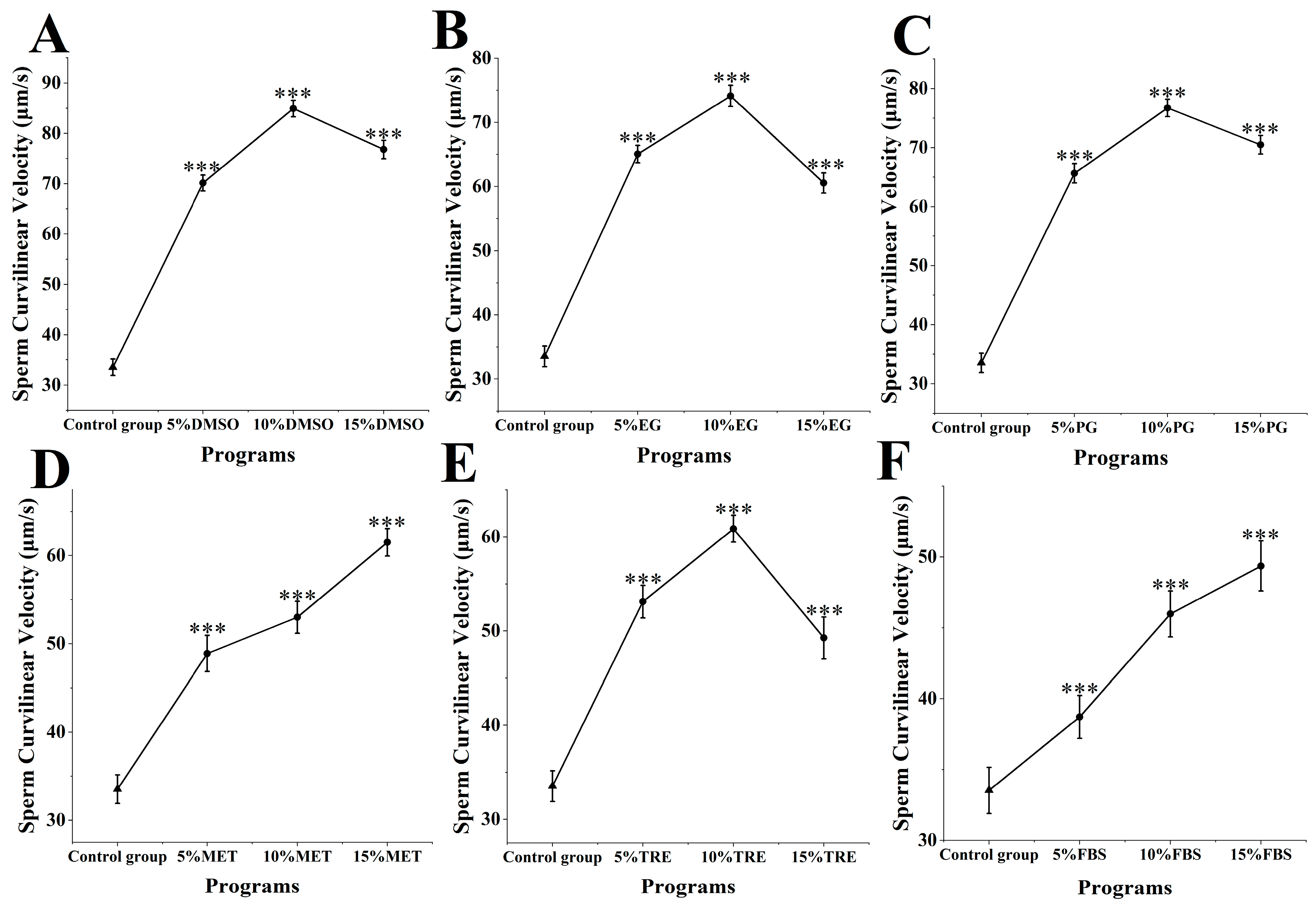
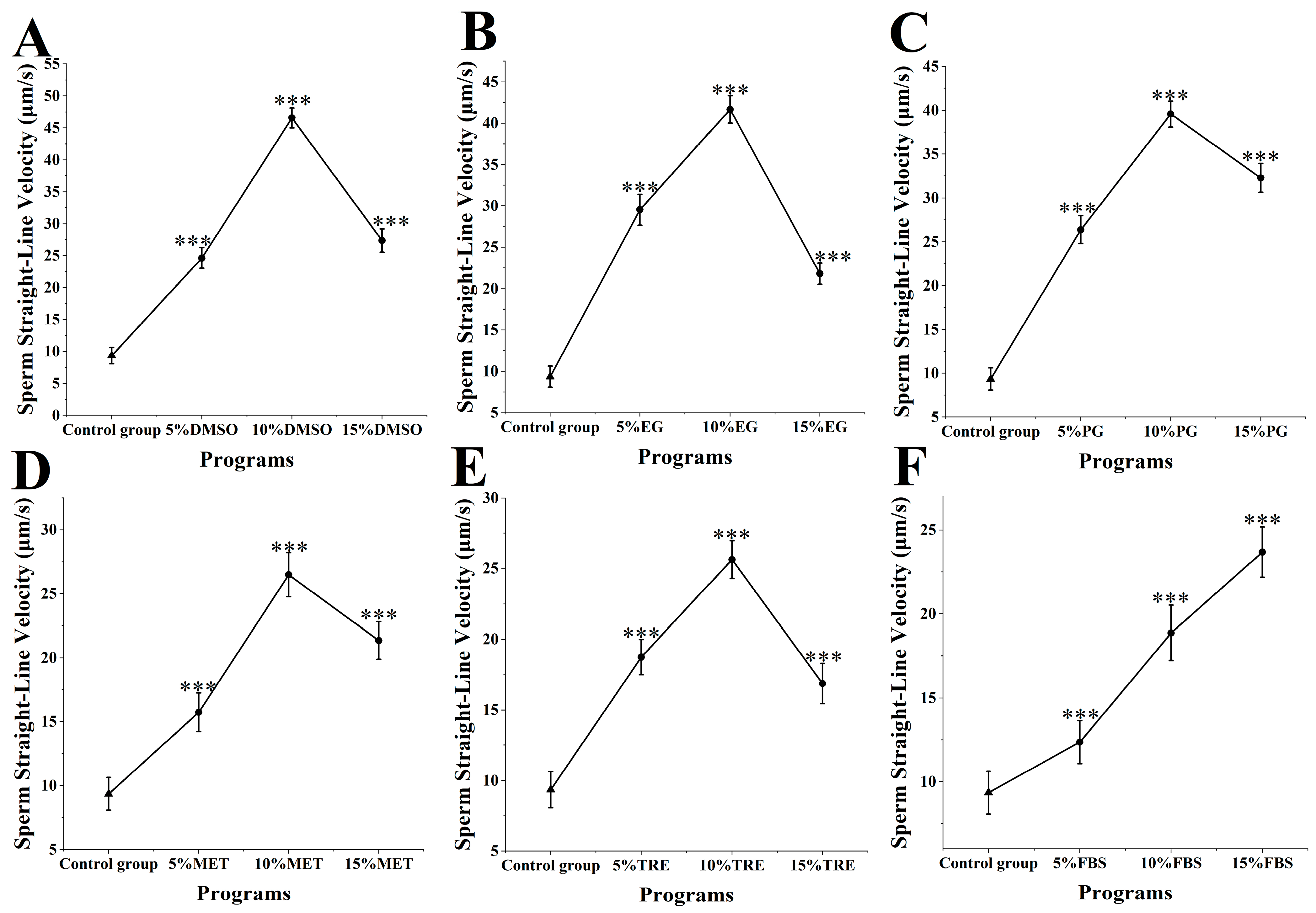
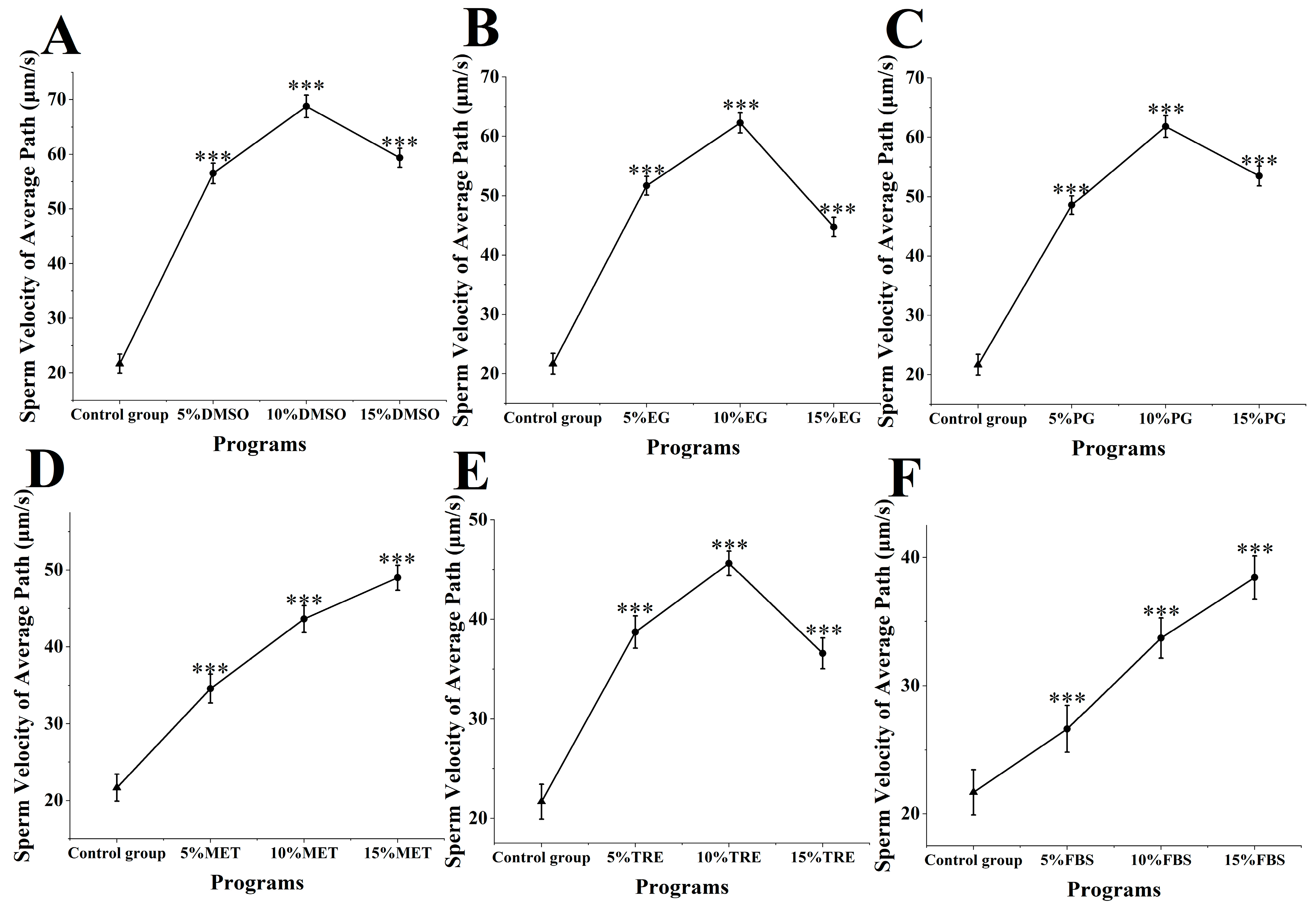
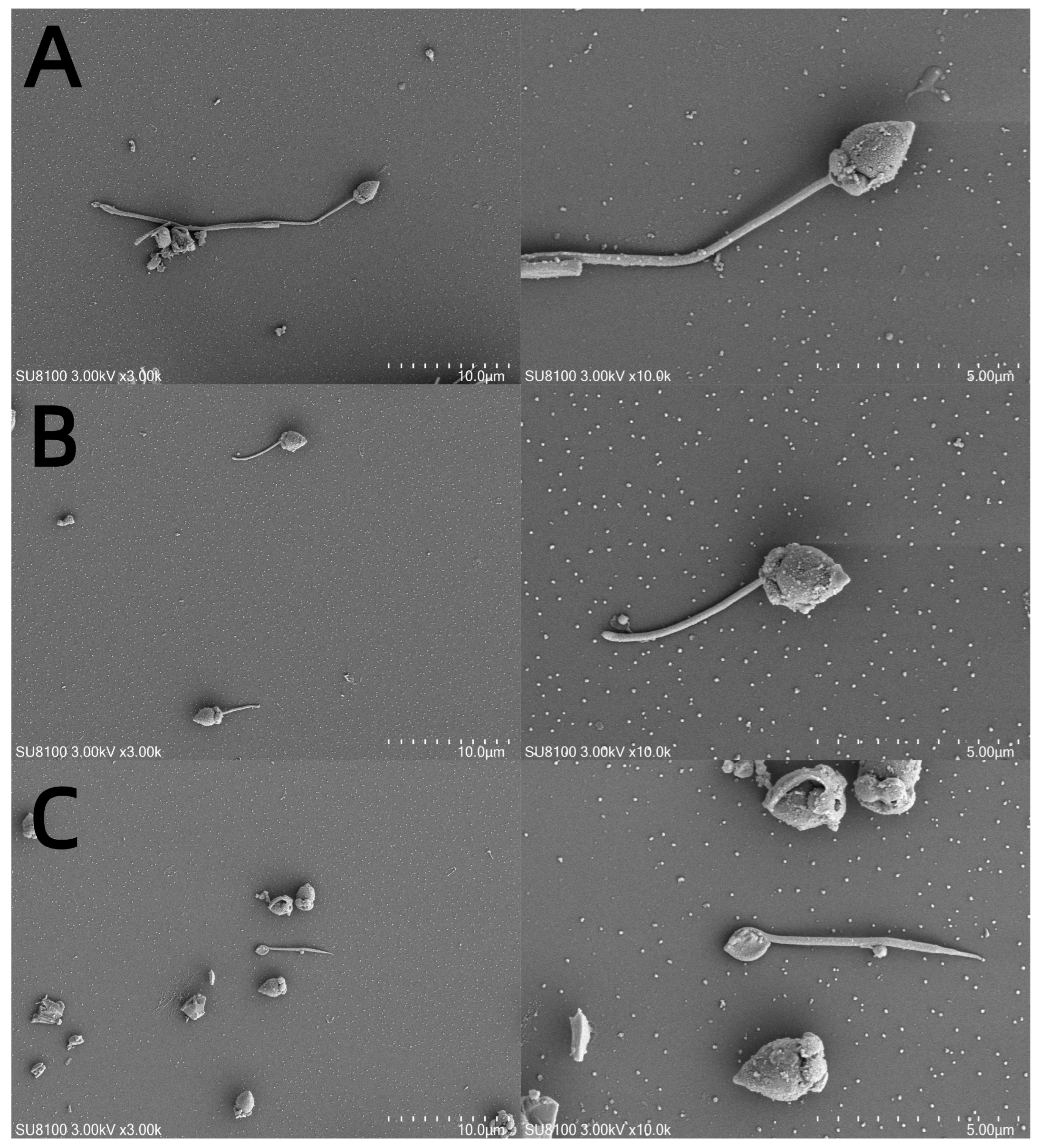
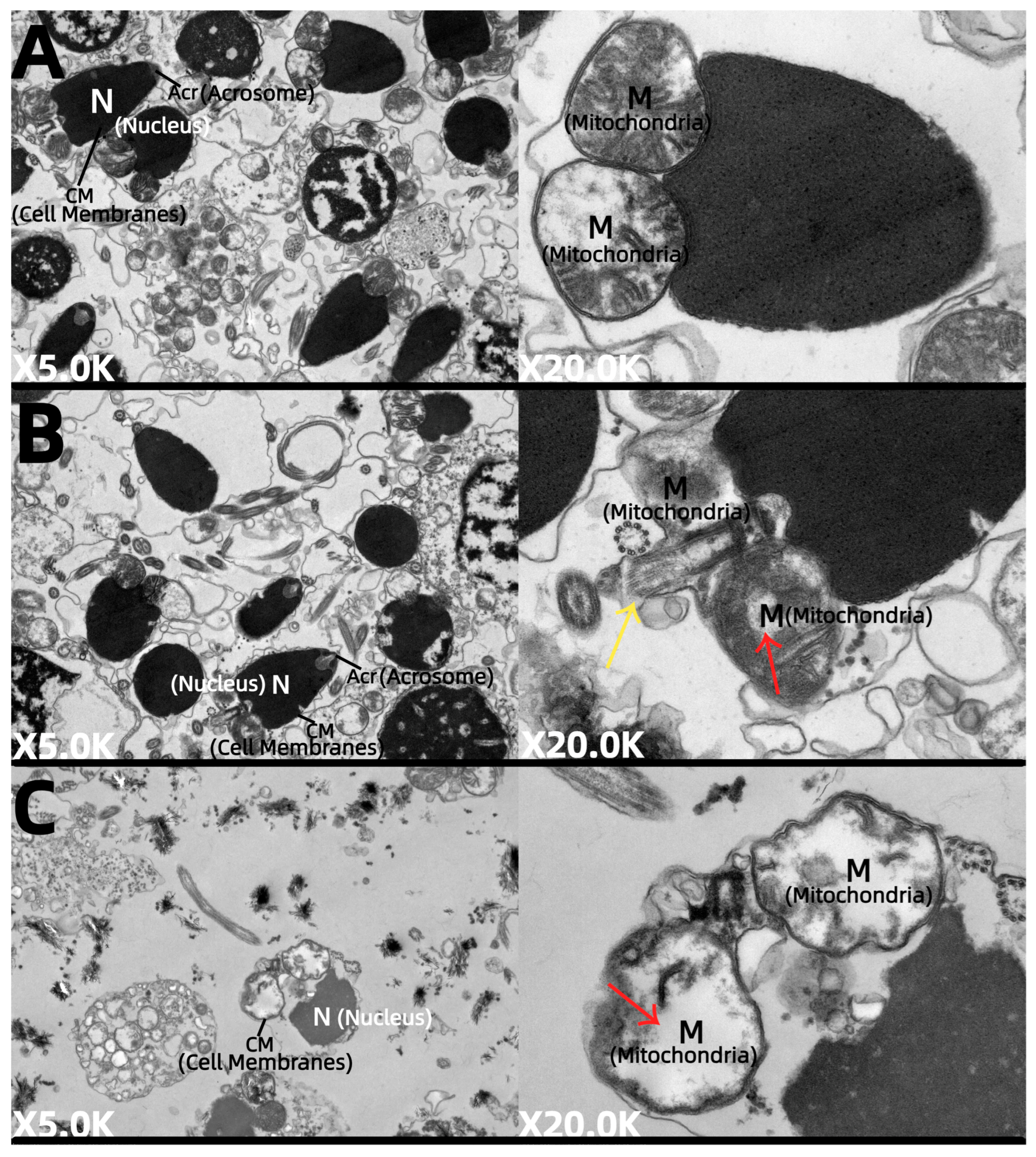
| Species | Shell Length (mm) | Wet Weight (g) | Gonad Weight (g) |
|---|---|---|---|
| M. nobiliss 1 | 55.63 | 56.24 | 15.74 |
| M. nobiliss 2 | 57.85 | 60.42 | 16.52 |
| M. nobiliss 3 | 62.46 | 62.76 | 16.43 |
| Group | Cryoprotectant Concentration (%) | Cryoprotectant Volume Added (µL) | Hank’s Solution (µL) |
|---|---|---|---|
| Control group | / | / | 1350 |
| A | 5% Dimethyl Sulfoxide (DMSO) | 75 | 1275 |
| 10% Dimethyl Sulfoxide (DMSO) | 150 | 1200 | |
| 15% Dimethyl Sulfoxide (DMSO) | 225 | 1125 | |
| B | 5% Ethylene Glycol | 59 | 1291 |
| 10% Ethylene Glycol | 118 | 1232 | |
| 15% Ethylene Glycol | 177 | 1173 | |
| C | 5% Propylene Glycol | 73 | 1277 |
| 10% Propylene Glycol | 146 | 1204 | |
| 15% Propylene Glycol | 219 | 1131 | |
| D | 5% Methanol | 43 | 1307 |
| 10% Methanol | 86 | 1264 | |
| 15% Methanol | 129 | 1221 | |
| E | 5% Trehalose | 50 | 1300 |
| 10% Trehalose | 100 | 1250 | |
| 15% Trehalose | 150 | 1200 | |
| F | 5% Fetal Bovine Serum (FBS) | 75 | 1275 |
| 10% Fetal Bovine Serum (FBS) | 150 | 1200 | |
| 15% Fetal Bovine Serum (FBS) | 225 | 1125 |
Disclaimer/Publisher’s Note: The statements, opinions and data contained in all publications are solely those of the individual author(s) and contributor(s) and not of MDPI and/or the editor(s). MDPI and/or the editor(s) disclaim responsibility for any injury to people or property resulting from any ideas, methods, instructions or products referred to in the content. |
© 2025 by the authors. Licensee MDPI, Basel, Switzerland. This article is an open access article distributed under the terms and conditions of the Creative Commons Attribution (CC BY) license (https://creativecommons.org/licenses/by/4.0/).
Share and Cite
Li, M.; Fu, Z.; Yu, G.; Ma, Z. Effects of Different Cryoprotectants on Cryopreservation of Sperm from Noble Scallop Mimachlamys nobilis. J. Mar. Sci. Eng. 2025, 13, 607. https://doi.org/10.3390/jmse13030607
Li M, Fu Z, Yu G, Ma Z. Effects of Different Cryoprotectants on Cryopreservation of Sperm from Noble Scallop Mimachlamys nobilis. Journal of Marine Science and Engineering. 2025; 13(3):607. https://doi.org/10.3390/jmse13030607
Chicago/Turabian StyleLi, Minghao, Zhengyi Fu, Gang Yu, and Zhenhua Ma. 2025. "Effects of Different Cryoprotectants on Cryopreservation of Sperm from Noble Scallop Mimachlamys nobilis" Journal of Marine Science and Engineering 13, no. 3: 607. https://doi.org/10.3390/jmse13030607
APA StyleLi, M., Fu, Z., Yu, G., & Ma, Z. (2025). Effects of Different Cryoprotectants on Cryopreservation of Sperm from Noble Scallop Mimachlamys nobilis. Journal of Marine Science and Engineering, 13(3), 607. https://doi.org/10.3390/jmse13030607









